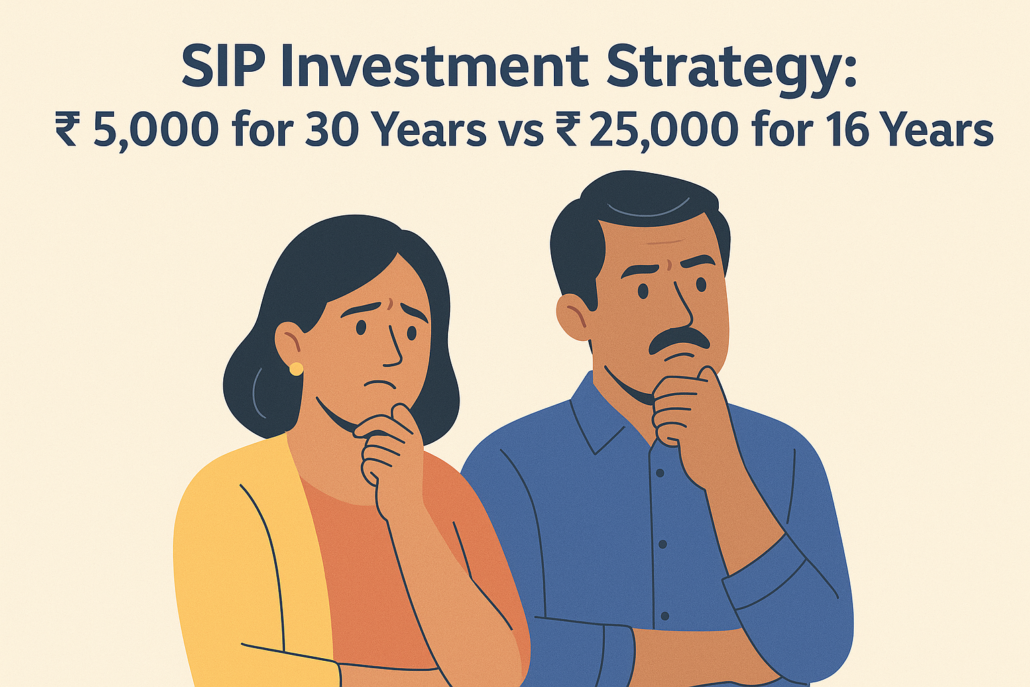Understanding SIP Investment Strategies for Long-Term Wealth Creation
Systematic Investment Plans (SIPs) have become a cornerstone for middle-class Indians aiming for financial stability. By investing a fixed amount regularly, individuals can harness the power of compounding to build substantial wealth over time. But the question arises: is it better to invest Rs 5,000 monthly for 30 years or Rs 25,000 monthly for 16 years?
The Power of Compounding in SIP Investments
Compounding is the process where the returns on your investments start generating their own returns. In SIPs, the longer you stay invested, the more you benefit from compounding. This is especially crucial for middle-class investors who start with smaller amounts.
Comparing Rs 5,000 SIP for 30 Years vs Rs 25,000 SIP for 16 Years
Let’s delve into the numbers:
| Investment Plan | Monthly SIP | Duration | Total Investment | Expected Return (12% p.a.) | Maturity Amount |
|---|---|---|---|---|---|
| Rs 5,000 SIP for 30 Years | Rs 5,000 | 30 Years | Rs 18,00,000 | 12% | Rs 1,54,04,866 |
| Rs 25,000 SIP for 16 Years | Rs 25,000 | 16 Years | Rs 48,00,000 | 12% | Rs 1,36,44,641 |
Despite investing a smaller total amount, the Rs 5,000 SIP over 30 years yields a higher maturity amount due to the extended investment horizon and compounding effect.
Why Long-Term SIPs Benefit Middle-Class Investors
For the middle-class, consistent and long-term investments align well with financial goals like children’s education, buying a home, or retirement planning. Starting early with manageable amounts can lead to significant wealth accumulation without straining monthly budgets. SIP Investment Strategy as getting the benefit of compounding in long learn is best option for middle class families.
They can’t afford huge SIP at one go. They need to eat the whole elephant with small bites.
Emotional and Financial Security Through SIPs
Investing in SIPs provides not just financial growth but also emotional peace. Knowing that you’re steadily building a corpus for future needs reduces financial anxiety, a common concern among middle-class families.
SIPs as a Tool for Financial Discipline
Regular SIP investments instill financial discipline, encouraging individuals to prioritize savings over impulsive spending. This habit is particularly beneficial for middle-class households aiming to secure their financial future.
Flexibility and Accessibility of SIPs
SIPs offer flexibility in terms of investment amounts and durations. Middle-class investors can start with as low as Rs 500 per month and increase the amount as their income grows, making it an accessible investment option.
Tax Benefits Associated with SIPs
Investing in Equity-Linked Saving Schemes (ELSS) through SIPs allows investors to claim tax deductions under Section 80C of the Income Tax Act, up to Rs 1.5 lakh annually. This dual benefit of tax saving and wealth creation is advantageous for the middle-class.
SIPs vs Other Investment Options
Compared to traditional savings methods like fixed deposits or recurring deposits, SIPs in mutual funds have the potential to offer higher returns, albeit with associated market risks. For middle-class investors seeking growth, SIPs present a compelling alternative.
Importance of Starting Early is the best SIP Investment Strategy
The earlier you start investing in SIPs, the more time your money has to grow. Even small amounts invested early can lead to substantial wealth due to the compounding effect, emphasizing the importance of early financial planning.
Adjusting SIPs According to Life Stages
As income levels change over time, middle-class investors can adjust their SIP amounts to align with their financial goals and life stages, ensuring continued progress towards wealth accumulation.
Utilizing SIP Calculators for Planning
Online SIP calculators are valuable tools that help investors project potential returns based on different investment amounts and durations, aiding in informed decision-making.
Overcoming Market Volatility with SIPs
SIPs help mitigate market volatility by averaging the purchase cost of mutual fund units over time, a strategy known as rupee cost averaging. This approach is beneficial for middle-class investors concerned about market fluctuations.
Cashbabu Gyan
For the Indian middle-class, SIPs represent a pathway to financial empowerment. By starting early, staying consistent, and leveraging the power of compounding, even modest monthly investments can lead to substantial wealth over time. Remember, it’s not about how much you invest, but how long you stay invested.
Frequently Asked Questions on SIP Investment Strategy
Q1: What is the minimum amount required to start a SIP?
Most mutual fund houses allow SIPs starting from Rs 500 per month, making it accessible for middle-class investors.
Q2: Can I increase my SIP amount over time?
Yes, you can increase your SIP amount through a feature called ‘Step-up SIP’, aligning with your income growth.
Q3: Are SIP returns guaranteed?
No, SIP returns are subject to market risks. However, investing in diversified mutual funds over the long term can potentially yield favorable returns. So diversification is one of the best SIP Investment Strategy
Q4: How does SIP help in tax saving?
Investing in ELSS funds through SIPs allows tax deductions under Section 80C, up to Rs 1.5 lakh annually.
Q5: What happens if I miss a SIP installment?
Missing a SIP installment doesn’t attract penalties, but consistent investing is recommended for optimal returns.
Q6: Can I pause or stop my SIP?
Yes, SIPs offer flexibility to pause or stop investments, but it’s advisable to consult with your financial advisor before making such decisions.
Q7: Is SIP suitable for short-term goals?
While SIPs are more effective for long-term wealth creation, they can be tailored for short-term goals with appropriate fund selection.
![]()




Pingback: Diwali 2025 SIP Guide: ₹10,000 Monthly Investment vs Gold vs Nifty 50 – Which Creates More Wealth This Samvat? - Cash Babu